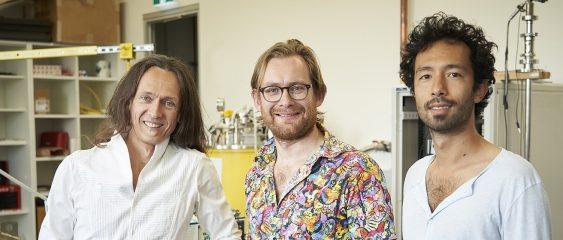Home > News & Events > Quantum collaboration backed for 2 more years

Professor Andrea Morello, Dr Vincent Mourik and Dr Serwan Asaad. Photo: Lee Henderson/UNSW
An international collaboration featuring three Australian universities has had its project to deliver quantum technologies extended by two years. It was announced at the end of June that the group will receive AU$2 million funding from The Department of Defence’s Next Generation Technologies Fund (NGTF).
The team’s research is aimed at protecting the particles that are at the heart of quantum devices from unwanted influence from the outside world. For technologies such as qubits – the workhorses of quantum computers – to operate, particles must be held in a precise but incredibly precarious balance in order to store, receive, or transmit information.
Atoms have an intrinsic property called spin, and this can be either up or down. Knowing the spin and being able to manipulate it allows engineers to create technologies that harness the bizarre phenomena that occur in the quantum world.
However, these balanced atoms are unwieldy, and just about any influence from the outside world can cause them to misbehave. This isn’t just vibrations from the room, it includes electric or magnetic field changes as well – considering that the atoms will be within a system that creates its own electric and magnetic fields that change frequently, protecting the integrity of the atoms is incredibly difficult.
The Australian team, which incorporates leaders in the field from UNSW, UTS, and Griffith University, are solving the problem by taking an approach that is analogous to how noise cancelling headphones work, using devices produced in ANFF-NSW cleanroom spaces at UNSW.
By creating a “microphone” that can detect the incoming interference, software that can interpret and create a counteracting signal, and a “speaker” that can generate a “noise cancelling” field, the team hope to be able to produce a protective bubble around the delicately balanced quantum particles, maintaining their integrity.
The research project, titled “quantum control based on real-time environment analysis by spectator qubits”, led in Australia by Griffith Research Fellow Dr Paz Silva, was initially awarded a grant of AU$3 million under the AUSMURI scheme in 2018.
And it’s already seen ground-breaking outcomes, including the solving of a 58-year roadblock that has major implications for the development of quantum computers and sensors. The UNSW contingent of the collaboration, led by Professor Andrea Morello, published research in Nature in March 2020 that demonstrated nuclear electric resonance, a concept predicted more than half a century ago but which has eluded experimental demonstration in a single atom until now. It provides a means to control or read the spin of an atom without the need of magnetic antennae that are both bulky and generate fields that are hard to confine. Triggered by a happy accident, the team were able to show that they could fabricate an electrode that could control the spin of an embedded antimony atom by affecting the surrounding electrons.
In terms of the noise cancelling headphones for qubits, engineering nuclear electric resonance on a device assists the pursuit of creating the microphone that would allow the team to generate their counteracting signal. It is now proven that the antimony atom is sensitive to both magnetic and electric stimuli, and even mechanical ones. Therefore, it serves as a multi-purpose “microphone”, capable of picking up a wide variety of noise sources.
This further backing sees an additional $2m injected that will enable the project to continue for two more years. The next phase of the project will focus on integrating together all the components of noise-cancelling system, and demonstrating a practical advantage in the performance of the resulting quantum computer chip.
At the device level, the integration will require placing the two types of atom (the one carrying the quantum data, and the one sensing the noise) in close proximity, and integrating them with fast and accurate nanoscale control and readout devices. The ANFF facilities will be used to engineer and fabricate these devices, with the exquisite control at the nanometre scale necessary for this ambitious project to succeed.
Read the original announcement here. Additional information on the nuclear electric resonance discovery can be found here.
